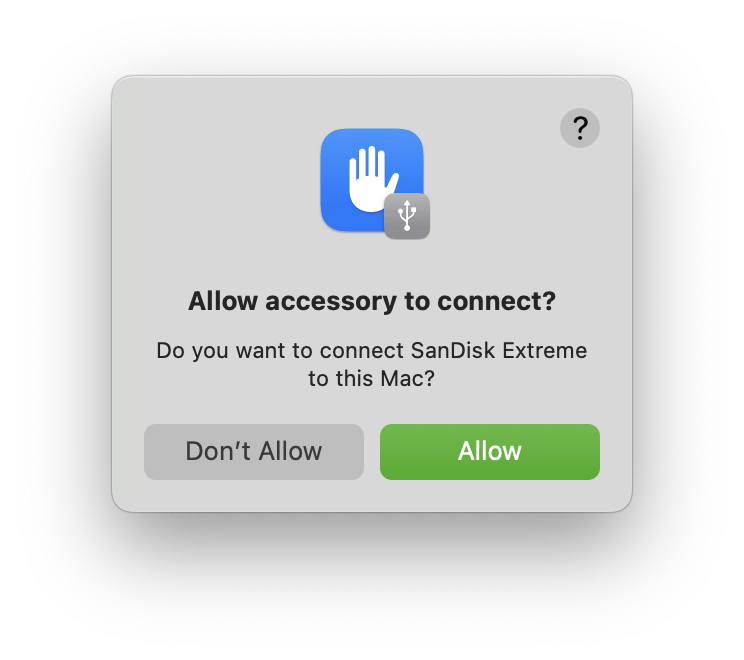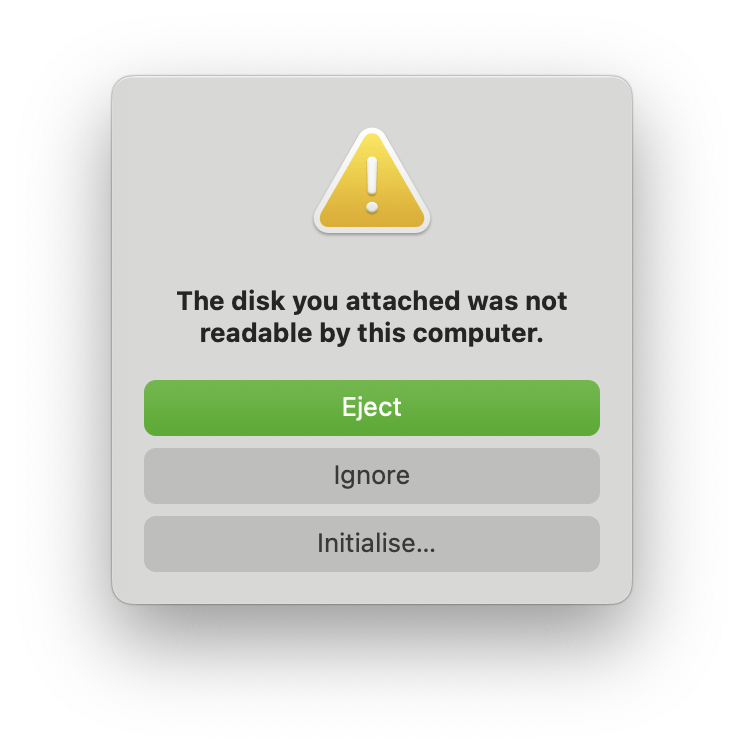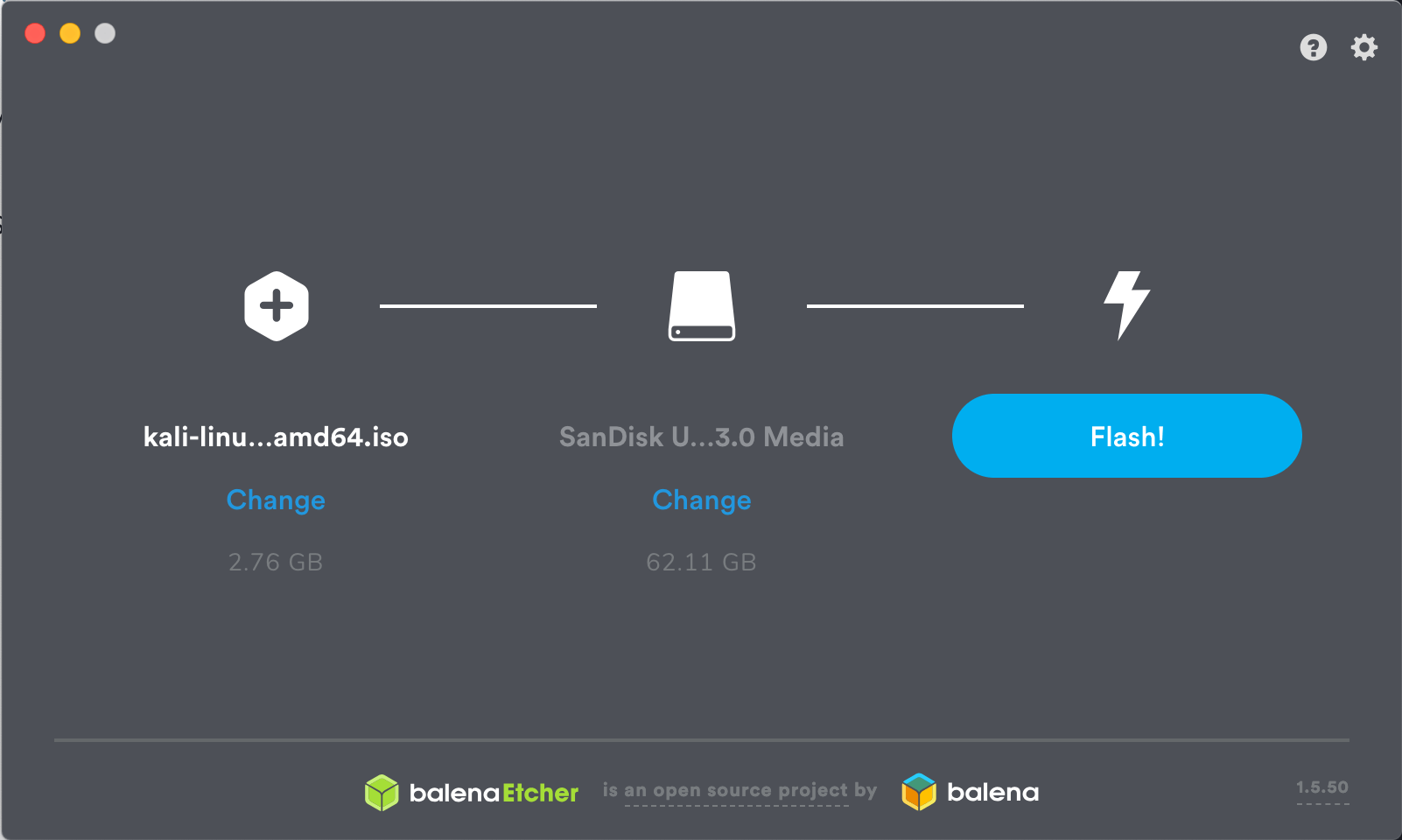Making a Kali Bootable USB Drive (macOS/OS X)
Table of Contents
Our favorite way, and the fastest method, for getting up and running with Kali Linux is to run it “live” from a USB drive. This method has several advantages:
- It’s non-destructive - it makes no changes to the host system’s hard drive or installed OS, and to go back to normal operations, you simply remove the “Kali Live” USB drive and restart the system.
- It’s portable - you can carry Kali Linux in your pocket and have it running in minutes on an available system
- It’s customizable - you can roll your own custom Kali Linux ISO image and put it onto a USB drive using the same procedures
- It’s potentially persistent - with a bit of extra effort, you can configure your Kali Linux “live” USB drive to have persistent storage, so the data you collect is saved across reboots
In order to do this, we first need to create a bootable USB drive which has been set up from an ISO image of Kali Linux.
What You’ll Need
- A verified copy of the appropriate ISO image of the latest Kali build image for the system you’ll be running it on.
- See the details on downloading official Kali Linux images.
- As you’re running under macOS/OS X, you can use the
ddcommand, which should be pre-installed, or use Etcher. - A USB thumb drive, 4GB or larger.
- Systems with a direct SD card slot can use an SD card with similar capacity. The procedure is identical.
Kali Linux Live USB Install Procedure
The specifics of this procedure will vary depending on whether you’re doing it on a Windows, Linux, or macOS/OS X system.
Creating a Bootable Kali USB Drive on macOS/OS X (DD)
macOS/OS X is based on UNIX, so creating a bootable Kali Linux USB drive in an macOS/OS X environment is similar to doing it on Linux.
Once you’ve downloaded and verified your Kali ISO files, you use dd to copy it over to your USB drive.
If you would prefer to use Etcher, then follow the same directions as a Windows user. Note that the USB drive will have a path similar to /dev/disk2.
WARNING: You can easily overwrite a disk drive you didn’t intend to with dd if you do not understand what you are doing, or if you specify an incorrect output path. Double-check what you’re doing before you do it, it’ll be too late afterwards.
Consider yourself warned.
- Without the USB drive plugged into the system, open a Terminal window, and type the command
diskutil listat the command prompt. You will get a list of the device paths (looking like /dev/disk0, /dev/disk1, etc.) of the disks mounted on your system, along with information on the partitions on each of the disks.
user@mbp ~ % diskutil list
/dev/disk0 (internal, physical):
#: TYPE NAME SIZE IDENTIFIER
0: GUID_partition_scheme *1.0 TB disk0
1: Apple_APFS_ISC Container disk1 524.3 MB disk0s1
2: Apple_APFS Container disk3 994.7 GB disk0s2
3: Apple_APFS_Recovery Container disk2 5.4 GB disk0s3
/dev/disk3 (synthesized):
#: TYPE NAME SIZE IDENTIFIER
0: APFS Container Scheme - +994.7 GB disk3
Physical Store disk0s2
1: APFS Volume macOS - Data 547.8 GB disk3s1
2: APFS Volume macOS 11.2 GB disk3s3
3: APFS Snapshot com.apple.os.update-... 11.2 GB disk3s3s1
4: APFS Volume Preboot 7.2 GB disk3s4
5: APFS Volume Recovery 1.0 GB disk3s5
6: APFS Volume VM 3.2 GB disk3s6
user@mbp ~ %
- Plug your USB drive into your Apple computer’s USB port. Depending on the version of macOS/OS X as well as what was previously on the USB, you may get a series of prompts.
Go ahead and press “Allow” (as long as you trust the device!):
The data previously on the USB, macOS/OS X is unable to automatically mount it. We already have a backup of the data, so we are not worried, so we are just going to “Ignore”:
- Now run the same command, “
diskutil list” a second time. The output will look something (again, not exactly) like this, showing an additional device which wasn’t there previously. Your USB drive’s path will most likely be the last one. In any case, it will be one which wasn’t present before. For our example, you can see that there is now a /dev/disk4 which wasn’t previously present, a 64GB USB drive:
user@mbp ~ % diskutil list
/dev/disk0 (internal, physical):
#: TYPE NAME SIZE IDENTIFIER
0: GUID_partition_scheme *1.0 TB disk0
1: Apple_APFS_ISC Container disk1 524.3 MB disk0s1
2: Apple_APFS Container disk3 994.7 GB disk0s2
3: Apple_APFS_Recovery Container disk2 5.4 GB disk0s3
/dev/disk3 (synthesized):
#: TYPE NAME SIZE IDENTIFIER
0: APFS Container Scheme - +994.7 GB disk3
Physical Store disk0s2
1: APFS Volume macOS - Data 547.9 GB disk3s1
2: APFS Volume macOS 11.2 GB disk3s3
3: APFS Snapshot com.apple.os.update-... 11.2 GB disk3s3s1
4: APFS Volume Preboot 7.2 GB disk3s4
5: APFS Volume Recovery 1.0 GB disk3s5
6: APFS Volume VM 3.2 GB disk3s6
/dev/disk4 (external, physical):
#: TYPE NAME SIZE IDENTIFIER
0: GUID_partition_scheme *62.7 GB disk4
1: Microsoft Basic Data 62.7 GB disk4s1
user@mbp ~ %
- Unmount the drive (assuming, for this example, the USB drive is /dev/disk4 - do not simply copy this, verify the correct path on your own system!):
user@mbp ~ % diskutil unmountDisk /dev/disk4
Unmount of all volumes on disk4 was successful
user@mbp ~ %
- Proceed to (carefully!) image the Kali ISO file on the USB device. We will be assuming that the ISO image you’re writing is named “kali-linux-2025.2-live-amd64.iso” and is in your current working directory.
user@mbp ~ % file kali-linux-2025.2-live-amd64.iso
kali-linux-2025.2-live-amd64.iso: ISO 9660 CD-ROM filesystem data (DOS/MBR boot sector) 'Kali Linux amd64' (bootable)
user@mbp ~ %
DD’s blocksize parameter can be increased, and while it may speed up the operation of the dd command, it can occasionally produce unbootable USB drives, depending on your system and a lot of different factors. The recommended value, “bs=4M”, is conservative and reliable.
While ‘/dev/diskX’ is used in the command, the ‘/dev/diskX’ should be replaced with the drive discovered previously.
Please use the correct device name from the previous step.
We will replace “/dev/diskX” with “/dev/rdiskX” (extra r) to improve the write speeds.
$ sudo dd if=kali-linux-2025.2-live-amd64.iso of=/dev/rdiskX bs=4M status=progress
There is a chance you may receive an error when running the above command: dd: invalid number: '4M' or dd: bs: illegal numeric value.
If this is the case, please change the 4M to be 4m.
Additionally, increasing the blocksize (bs) will speed up the write progress, but will also increase the chances of creating a bad USB drive. Using the given value on macOS/OS X has produced reliable images consistently.
Another potential error will be that status=progress does not work on your version of macOS. If this is the case, remove this section and instead use CTRL+T to measure status.
Imaging the USB drive can take a good amount of time, over half an hour is not unusual, as the sample output below shows. Be patient!
The dd command will only provide feedback as it writes if status=progress is used, otherwise will only show when it’s completed, but if your drive has an access indicator, you’ll probably see it flickering from time to time. The time to dd the image across will depend on the speed of the system used, USB drive itself, and USB port it’s inserted into. Once dd has finished imaging the drive, it will output something that looks like this:
893+1 records in
893+1 records out
3748147200 bytes transferred in 915.043994 secs (4096139 bytes/sec)
After DD completes, macOS/OS X may try to remount the USB device again. If so, you will get the same pop-up as before.
We suggest the default option this time, “Eject”.
And that’s it!
Creating a Bootable Kali USB Drive on macOS/OS X (Etcher)
If you would like a graphical option to flash, we recommend Etcher
- Download and run Etcher.
- Choose the Kali Linux ISO file to be imaged with “select image” and verify that the USB drive to be overwritten is the correct one. Click the “Flash!” button once ready.
- Once Etcher alerts you that the image has been flashed, you can safely remove the USB drive.
You can now boot into a Kali Live / Installer environment using the USB device.
Booting USB on Apple
To boot from an alternate drive on an macOS/OS X system, bring up the boot menu by pressing the Option key immediately after powering on the device and select the drive you want to use.
For more information, see Apple’s knowledge base.
Updated on: 2025-Jun-18
Author:
g0tmi1k


